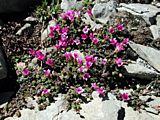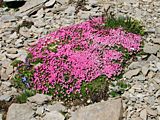Abandonment of sex in the cold?
The obvious constraints on sexual reproduction in the cold (fewer pollinators, short growing season) have led to predictions of increasing wind pollination, vegetative reproduction, selfing, and agamospermy at high altitudes most of which tend to promote the genetic uniformity of populations.
However, available facts and indirect evidence contradict the classical view that sexual reproduction is less important in alpine habitats:
- In the old world, only 16 % of alpine flowers are pollinated by wind, less than at low altitudes (22 %).
- Even if pollinator-species richness decreases with altitude, the proportion of plant species pollinated by animals and promoting out-crossing does not decrease.
- Reduction in size is a conspicuous feature of alpine plants. However, when compared to lowland species, the size of flowers is maintained. Relatively, alpine plants invest even more in reproductive structures.
- At the level of individual shoots, clonal plants do not significantly reduce their effort to reproduce sexually.
- The expectation that populations of alpine plants are genetically less diverse than plants at low altitude is not supported by the available studies.
Sex remains important, even for clonal plants
Saxifraga oppositifolia is an arctic-alpine plant pollinated by bumblebees and promoting outcrossing by protogynous flowers. Gugerli (1998) found no indications for increased selfing or self-compatibility at high elevations.
Epilobium fleischeri is a pioneer plant from glacier forefields in the Swiss Alps. In spite of intensive clonal growth, there is no reduction in sexually produced seeds when compared to its sister-species from the lowland (Stöcklin and Favre 1994).
Alpine vegetation is famous for the density of flowers. At peak flowering, the fraction of flowers simultaneously open is even larger in alpine than in lowland species (Fabbro and Körner). Such observations do not indicate a reduction of sexual reproduction at high altitude.



